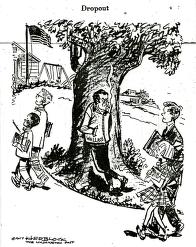|

"Dropout" cartoon from Greenfield Recorder-Gazette newspaper
|
Summary and Objective
Students will understand that, because of the racial climate of the late 1950s and early 1960s, the process of school integration was slow, scary and, at times, threatening for both blacks and whites. They will understand both the courage and vitriol experienced by the "Little Rock Nine" in 1957, and the clashing decisions of Governor Orville Faubus and President Eisenhower.
Teaching Plan
Step 1.
Pre-Activity: Learn and review the following vocabulary: citizen, integration, NAACP, oppression, racism, resistance, segregationist, separate but equal. Then define "school integration" with the students as a time when black and white schools were segregated. Discuss what the reasons were for having segregated schools.
Step 2.
Use the two links below to learn about the events leading up to the Brown decision and the issues in its aftermath. The first link is written by students, making it somewhat student friendly (though with some inherent editing problems.) However, the second is more comprehensive in its explanation.
Step 3.
View the political cartoon "Dropout" from the digital collection. Although this was published in the succeeding decade with the perspective of a northern political cartoonist, the angst in the south has remained. With the notion that some questions are best asked now and others best asked in step #7, have the students discuss their impressions of the cartoon with questions such as, "What do you notice about this cartoon?", "From the cartoon, how is integration going?", "How do the students feel as they are walking up the driveway?" or "Is there anything puzzling to you about the cartoon?" (If questions specific to George Wallace are asked, background information about him can be broached.) Pointing out that the issues of desegregation were actually much more complicated, the next steps will look at an example of what really happened.
Step 4.
Use the third link to learn about Melba Patillo Beals' perspectives and experiences in the Little Rock desegregation at Central High School. Her family's concerns and even objections, the reactions of her friends, the solidarity of the nine black students, and the support of Daisy Bates help set the stage for understanding the courage and sacrifice of the students. Through Melba, the outside support of the federal judge, Danny, her paratrooper protector and Link, her secret admirer and guardian, we can learn her fears and hesitancy yet her strength and tenacity. An additional resource, particularly to help understand her relationships within the school, is her book "Warriors Don't Cry".
Step 5.
The fourth link is to help research the participants in the Central High School desegregation: The Little Rock Nine students (Minnijean Brown, Elizabeth Eckford, Ernest Green, Thelma Mothershed, Melba Patillo, Gloria Ray, Terrance Roberts, Jefferson Thomas, Carlotta Walls), NAACP officers Daisy Bates and Milton Crenshaw, white students Hazel Massery and Craig Rains, Vice-Principal Elizabeth Huckaby, Arlie Methany, army liaison, the 101st Airborne, Arkansas National Guard, Governor Orville (or Orval) Faubus, President Dwight Eisenhower, Judge Ronald Davis. This will help create characters for the next step in this project.
Step 6.
Establish a story line, involving one of the characters to show the controversy of the desgregation of Central High School. As an example, with the choice of Melba Patillo, there are many perspectives, some with self-interest, some out of fear, some out of nurturing, some out of dreams. Some members of Melba's family were concerned for her and their safety. Others, such as her grandmother, supported her fully. Some of her friends disavowed their friendship while others helped to buoy her. As begun in Step #4, the nine students and their supporters gave each other strength. The Governor, the President and the federal judge clashed on how to proceed. Soldiers, National Guard troops, white members of the school community (and Link) developed relationships with Melba.
Step 7.
Now go back to the political cartoon "Dropout" from the digital collection. Have the students again discuss their impressions of the cartoon, perhaps even revisiting some of the same questions. With their current knowledge, more apt questions can be asked, such as "How do you now look at the cartoon?", "What is the cartoon showing about the role of Wallace [and other politicians] in school integration?", "Why call Wallace 'dropout'?", "What is missing in the cartoon?" or "What would you include in this cartoon that is not there?"
Step 8.
Put together the steps of this project with the question, "Has integration been successful?" or further, "Did integration succeed because Wallace and other politicians failed?"
|




